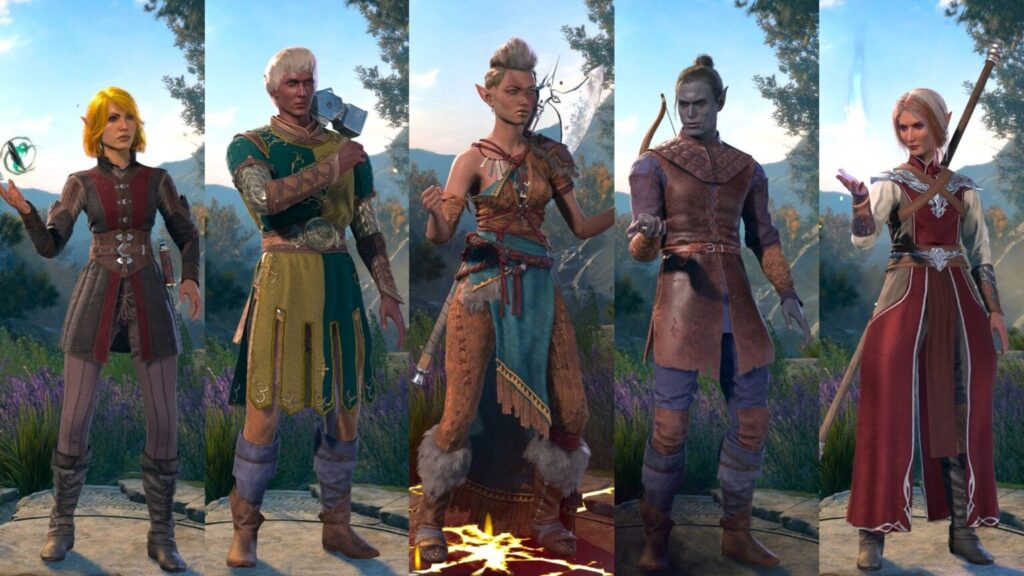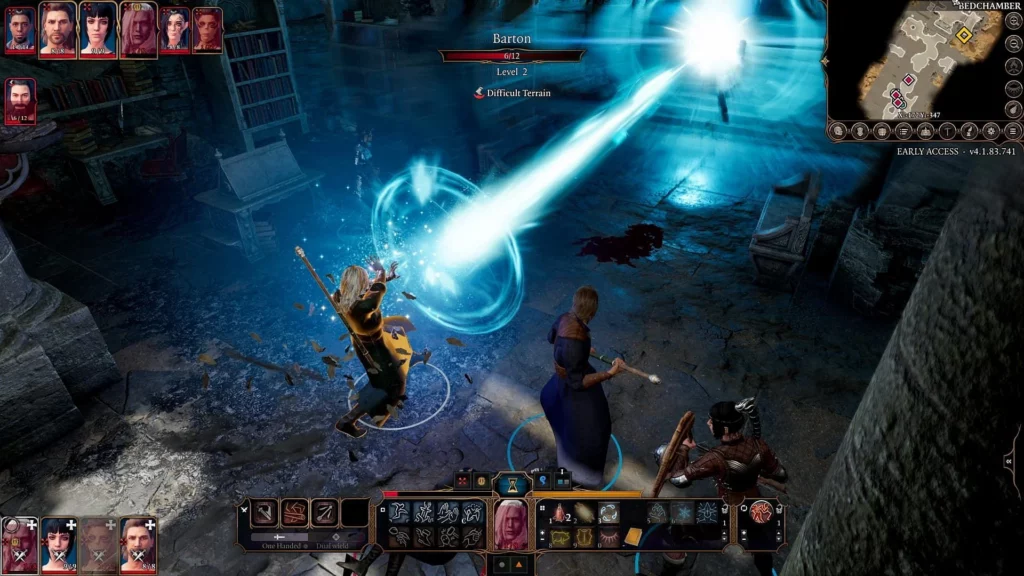Baldur’s Gate 2 earned acclaim as one of the greatest RPGs back in 2000, praised for its faithful adaptation of the Advanced Dungeons and Dragons 2nd Edition tabletop game. Even after over two decades, it remains the pinnacle of its genre. Larian Studios took on the monumental task of creating a sequel, and Baldur’s Gate 3 ($59.99 for PC, $69.99 for PlayStation 5) has surpassed all expectations.
This incredible RPG experience, now based on Dungeons & Dragons 5th Edition, offers an astonishing number of choices that dramatically influence each 60-plus-hour playthrough. The game’s engine can handle almost anything you try to do in D&D. In a year already packed with remarkable games like The Legend of Zelda: Tears of the Kingdom and Street Fighter 6, Baldur’s Gate 3 shines as one of the best, earning a rare five-star rating from anybody who plays it. Let’s take a look at everything that makes this game great.
Table of contents
The Characters
In Baldur’s Gate 3, your adventure begins with your hero facing unimaginable danger, captured by sinister Mind Flayers. They implant a strange creature called the tadpole into your brain, aiming to transform you into one of them. However, a chaotic attack by dimension-hopping red dragons interrupts their plans, causing chaos and freeing you from their control. You and potential allies find yourselves washed up on the Sword Coast’s beaches, where your journey truly begins.
Before diving into the story, you create your character using Baldur’s Gate 3’s character creator. Here, you’ll make crucial decisions that shape your adventure. Choose from premade characters or craft your own, picking from 10 races and 12 classes, each offering unique abilities and traits. You’ll also select starting spells, backgrounds, and ability points to tailor your character to your playstyle. Baldur’s Gate 3’s character creator sets the stage for the countless choices and adventures that lie ahead.
Of course, you have the freedom to customize your character’s appearance. While there aren’t endless sliders for every detail, like in some games, most races offer several preset faces and body types. You can choose from various options for eyes, hair, skin color, body art, hairstyles, makeup, and scars. What’s really neat is that your character can be male, female, or non-binary/other, and you can select your identity, voice, and genitals. Baldur’s Gate 3 allows you to create the character you envision for the exciting journey ahead.

The Gameplay
Baldur’s Gate 3 follows the classic style of CRPG (Classic Role-Playing Game), meaning you won’t be exploring the world from a first-person perspective like Cyberpunk 2077 or from a behind-the-back third-person perspective like Skyrim or Witcher 3. Instead, you’ll mostly view the world from above, offering a comprehensive view of your party and surroundings. You have the flexibility to zoom in and out, rotate the view, and pan over a limited area to examine distant places. Additionally, there’s an option to switch to a completely flat, zoomed-out tactical mode for a different perspective.
The interface uses a click-and-go system with intricately complex mechanics. Each character’s background, skills, and stats provide them with numerous potential actions in any situation. For instance, our Tiefling fey-touched warlock, originating from the Baldur’s Gate city-state with a criminal background, had access to a variety of cantrips, proficiency in arcana, deception, and sleight of hand, and knowledge of Tiefling history and culture, regional politics, and the criminal underworld.
These factors greatly influenced our dialogue choices and puzzle-solving approaches. For example, we utilized our character’s criminal knowledge to expose a street hustler’s con and our sleight-of-hand ability to uncover his pickpocket partner. If we had chosen a different character, like the Githyanki fighter Lae’zel, we would have had alternative approaches available, such as intimidation or brute force, to resolve the same issues.
The Dice Roll
Staying true to the mechanics of Dungeons & Dragons. Skill checks are at the core; every significant action in Baldur’s Gate 3 relies on a dice roll. You need to roll a virtual 20-sided die and achieve a result higher than the check’s number to succeed. The difficulty of the check varies, with easier actions requiring a roll of 5 or above, while more challenging checks may demand a 10, 15, or even a perfect 20. Your character’s attributes, such as strength, dexterity, and charisma, play a crucial role in these checks, with each skill check tied to a specific stat that may provide bonuses or penalties. Proficiencies, situational circumstances, items, and spells can also affect your chances of success.
Your choices in the game impact the narrative and your interactions with the character. Befriending or alienating individuals can open up or close off entire story paths, leading to diverse outcomes and consequences. Whether negotiating with Tiefling refugees or using magic to disguise yourself when attempting to pickpocket a merchant, every decision influences how characters perceive and interact with you. Baldur’s Gate 3 expertly captures the essence of tabletop role-playing games, offering a technically impressive experience where the vast array of possibilities is taken into account, providing crafted responses and voice acting for even the smallest interactions with NPCs.
The Combat
Combat in Baldur’s Gate 3 stays true to Dungeons & Dragons, but it’s more organized than just wandering around and chatting with folks. When a fight starts, the game switches to turn-based mode, where every character and creature takes turns based on their roll. Each turn, you can move a certain distance, take an action, or do a bonus action.
Actions include attacking, using skills, or casting spells. Magic classes offer versatility with spells, but physical classes have plenty of options too. For example, barbarians and fighters can attack or use special moves based on their subclass and weapon. No class is limited to just moving and hitting each turn. Bonus actions are extra moves you can do after your main action. They can be casting minor spells, making follow-up attacks, drinking potions, or even jumping to a different spot on the battlefield.
Like Tactics Ogre and X-Com, Baldur’s Gate 3 makes you think about distance, height, and angles of attack. There are also neat environmental interactions, like shooting an arrow to break a rope and dropping burning coals on enemies. Choosing the right spell or item can change the tide of battle. Fights are tough, as enemies can do anything your characters can. Just rushing in won’t work—you need to plan and think creatively, especially on harder difficulties.

The Campaign
The game is split into three acts, each packed with side quests, characters, and unique areas from Dungeons & Dragons lore. Baldur’s Gate 3 offers a variety of missions, from silly to serious, making it hard to turn down any encounter.
Almost every storyline is worth exploring. Saving a goblin in the druid grove gave us an easier way into goblin camps. Solving a murder, let us rent out the top floor of an inn. We even convinced a demon to break a hex by eliminating his followers and himself. Like a real D&D game, storylines and their consequences echo throughout the campaign.
This speaks to Baldur’s Gate 3’s vast narrative. Despite the threat of “174 hours of cutscenes,” we eagerly anticipated the next interaction. Party members, initially guarded, reveal captivating stories worthy of their own adventures. Choosing sides gains favor or ill will among them. This creates a realistic dynamic within the group. We looked forward to uncovering more about party members during camp rests or continuing our romances.
The game also embraces sexuality in a way rarely seen in video games. Relationships develop naturally, and the intimate scenes—while graphic—are not gratuitous. They range from funny to steamy to awkward, mirroring real life. However, Baldur’s Gate 3 has its flaws. It’s easy to accidentally upset someone or miss out on a storyline due to dialogue choices. Additionally, the start of Act 3 slows down the game’s pace, if only temporarily.
What Do You Need to Play?
To play Baldur’s Gate 3, your PC needs certain specs: an AMD FX 8350 or Intel Core i5 4690 CPU, an AMD RX 480 or Nvidia GeForce GTX 970 GPU (with 4GB of VRAM), 4GB of RAM, and 150GB of SSD storage. We tested it on three different computers: one with an Intel Core i7 10700K CPU and Nvidia GeForce RTX 3060 GPU, a laptop with an AMD Ryzen 9 5900HS CPU and Nvidia Geforce RTX 3060 GPU, and a remote gaming PC using Shadow with an AMD Epyc 7543 CPU and Nvidia RTX A4500 (which is similar to an AMD Ryzen 9 7900X and RTX 3070 Ti).
The game ran well on all setups, maintaining a stable 60 frames per second at 1080p and 1440p resolutions (with high graphics settings and DLSS enabled). Occasionally, the frame rate dropped in crowded areas, but overall, it was smooth. The visuals are rich, vibrant, and detailed, especially during close-up action, conversations, or cutscenes, surpassing games like Diablo IV or Hogwarts Legacy. You can play using either a mouse or a gamepad; the mouse makes navigating radial menus easier, while a gamepad simplifies character movement.
The games are getting better every year. Whenever we get a new rendition of a classic, we’re blown away by how good the graphics and gameplay feel. Considering Baldur has come out after 23 years, there have been monumental leaps in quality. Even if you’re too young to remember the first two games, there’s nothing stopping you from hopping on the bandwagon. Baldur’s Gate 3 is bound to be a staple in the gamer’s household for years to come, so don’t miss out.
